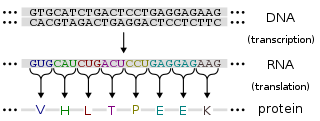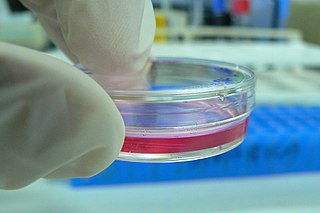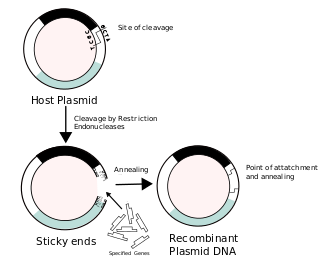
Protein production is the biotechnological process of generating a specific protein. It is typically achieved by the manipulation of gene expression in an organism such that it expresses large amounts of a recombinant gene. This includes the transcription of the recombinant DNA to messenger RNA (mRNA), the translation of mRNA into polypeptide chains, which are ultimately folded into functional proteins and may be targeted to specific subcellular or extracellular locations.

Deinococcus–Thermus is a phylum of bacteria with a single order, Deinococci, that are highly resistant to environmental hazards, also known as extremophiles. These bacteria have thick cell walls that give them gram-positive stains, but they include a second membrane and so are closer in structure to those of gram-negative bacteria. Cavalier-Smith calls this clade Hadobacteria.

Chinese hamster ovary (CHO) cells are an epithelial cell line derived from the ovary of the Chinese hamster, often used in biological and medical research and commercially in the production of recombinant therapeutic proteins. They have found wide use in studies of genetics, toxicity screening, nutrition and gene expression, particularly to express recombinant proteins. CHO cells are the most commonly used mammalian hosts for industrial production of recombinant protein therapeutics.

An expression vector, otherwise known as an expression construct, is usually a plasmid or virus designed for gene expression in cells. The vector is used to introduce a specific gene into a target cell, and can commandeer the cell's mechanism for protein synthesis to produce the protein encoded by the gene. Expression vectors are the basic tools in biotechnology for the production of proteins.

Chlorella is a genus of about thirteen species of single-celled green algae belonging to the division Chlorophyta. The cells are spherical in shape, about 2 to 10 μm in diameter, and are without flagella. Their chloroplasts contain the green photosynthetic pigments chlorophyll-a and -b. In ideal conditions cells of Chlorella multiply rapidly, requiring only carbon dioxide, water, sunlight, and a small amount of minerals to reproduce.

Microalgae or microphytes are microscopic algae invisible to the naked eye. They are phytoplankton typically found in freshwater and marine systems, living in both the water column and sediment. They are unicellular species which exist individually, or in chains or groups. Depending on the species, their sizes can range from a few micrometers (μm) to a few hundred micrometers. Unlike higher plants, microalgae do not have roots, stems, or leaves. They are specially adapted to an environment dominated by viscous forces.

Cell culture is the process by which cells are grown under controlled conditions, generally outside their natural environment. After the cells of interest have been isolated from living tissue, they can subsequently be maintained under carefully controlled conditions. These conditions vary for each cell type, but generally consist of a suitable vessel with a substrate or medium that supplies the essential nutrients (amino acids, carbohydrates, vitamins, minerals), growth factors, hormones, and gases (CO2, O2), and regulates the physio-chemical environment (pH buffer, osmotic pressure, temperature). Most cells require a surface or an artificial substrate to form an adherent culture as a monolayer (one single-cell thick), whereas others can be grown free floating in a medium as a suspension culture. The lifespan of most cells is genetically determined, but some cell culturing cells have been “transformed” into immortal cells which will reproduce indefinitely if the optimal conditions are provided.

Recombinant DNA (rDNA) molecules are DNA molecules formed by laboratory methods of genetic recombination that bring together genetic material from multiple sources, creating sequences that would not otherwise be found in the genome.
Virus-like particles (VLPs) are molecules that closely resemble viruses, but are non-infectious because they contain no viral genetic material. They can be naturally occurring or synthesized through the individual expression of viral structural proteins, which can then self assemble into the virus-like structure. Combinations of structural capsid proteins from different viruses can be used to create recombinant VLPs. VLPs derived from the Hepatitis B virus (HBV) and composed of the small HBV derived surface antigen (HBsAg) were described in 1968 from patient sera. VLPs have been produced from components of a wide variety of virus families including Parvoviridae, Retroviridae, Flaviviridae, Paramyxoviridae and bacteriophages. VLPs can be produced in multiple cell culture systems including bacteria, mammalian cell lines, insect cell lines, yeast and plant cells.
Industrial fermentation is the intentional use of fermentation by microorganisms such as bacteria and fungi as well as eukaryotic cells like CHO cells and insect cells, to make products useful to humans. Fermented products have applications as food as well as in general industry. Some commodity chemicals, such as acetic acid, citric acid, and ethanol are made by fermentation. The rate of fermentation depends on the concentration of microorganisms, cells, cellular components, and enzymes as well as temperature, pH and for aerobic fermentation oxygen. Product recovery frequently involves the concentration of the dilute solution. Nearly all commercially produced enzymes, such as lipase, invertase and rennet, are made by fermentation with genetically modified microbes. In some cases, production of biomass itself is the objective, like Single-cell protein and as in the case of baker's yeast and lactic acid bacteria starter cultures for cheesemaking. In general, fermentations can be divided into four types:
A cell-free system is an in vitro tool widely used to study biological reactions that happen within cells apart from a full cell system, thus reducing the complex interactions typically found when working in a whole cell. Subcellular fractions can be isolated by ultracentrifugation to provide molecular machinery that can be used in reactions in the absence of many of the other cellular components. Eukaryotic and prokaryotic cell internals have been used for creation of these simplified environments. These systems have enabled cell-free synthetic biology to emerge, providing control over what reaction is being examined, as well as its yield, and lessening the considerations otherwise invoked when working with more sensitive live cells.

An immobilized enzyme is an enzyme attached to an inert, insoluble material—such as calcium alginate. This can provide increased resistance to changes in conditions such as pH or temperature. It also lets enzymes be held in place throughout the reaction, following which they are easily separated from the products and may be used again - a far more efficient process and so is widely used in industry for enzyme catalysed reactions. An alternative to enzyme immobilization is whole cell immobilization.
Animal viruses are viruses that infect animals. Viruses infect all cellular life and although viruses infect every animal, plant, fungus and protist species, each has its own specific range of viruses that often infect only that species.
Cell-free protein synthesis, also known as in vitro protein synthesis or CFPS, is the production of protein using biological machinery in a cell-free system, that is, without the use of living cells. The in vitro protein synthesis environment is not constrained by a cell wall or homeostasis conditions necessary to maintain cell viability. Thus, CFPS enables direct access and control of the translation environment which is advantageous for a number of applications including co-translational solubilisation of membrane proteins, optimisation of protein production, incorporation of non-natural amino acids, selective and site-specific labelling. Due to the open nature of the system, different expression conditions such as pH, redox potentials, temperatures, and chaperones can be screened. Since there is no need to maintain cell viability, toxic proteins can be produced.
Mucor indicus is among the most important members of zygomycetes fungi. This dimorphic fungus is capable of production of several valuable products. Some strains of the fungus have been isolated from the traditional Indonesian food tempeh. M. indicus is nowadays used for production of several homemade food and beverages especially in Asia. This has also been successfully used as a safe nutritional source for fish and rat. The fungus is generally regarded as safe though there are few reports claiming that this is a pathogenic fungus.
High Five is an insect cell line that originated from the ovarian cells of the cabbage looper, Trichoplusia ni. It was developed by the Boyce Thompson Institute for Plant Research, Ithaca, NY.
Schneider 2 cells, usually abbreviated as S2 cells, are one of the most commonly used Drosophila melanogaster cell lines. S2 cells were derived from a primary culture of late stage Drosophila melanogaster embryos by Dr. Imogene Schneider, likely from a macrophage-like lineage.
Industrial enzymes are enzymes that are commercially used in a variety of industries such as pharmaceuticals, chemical production, biofuels, food & beverage, and consumer products. Due to advancements in recent years, biocatalysis through isolated enzymes is considered more economical than use of whole cells. Enzymes may be used as a unit operation within a process to generate a desired product, or may be the product of interest. Industrial biological catalysis through enzymes has experienced rapid growth in recent years due to their ability to operate at mild conditions, and exceptional chiral and positional specificity, things that traditional chemical processes lack. Isolated enzymes are typically used in hydrolytic and isomerization reactions. Whole cells are typically used when a reaction requires a co-factor. Although co-factors may be generated in vitro, it is typically more cost-effective to use metabolically active cells.

Chlorella vulgaris is a species of green microalga in the Division Chlorophyta. It is mainly used as a dietary supplement or protein-rich food additive in Japan.
Transient expression, more frequently referred to "transient gene expression", is the temporary expression of genes that are expressed for a short time after nucleic acid, most frequently plasmid DNA encoding an expression cassette, has been introduced into eukaryotic cells with a chemical delivery agent like calcium phosphate (CaPi) or polyethyleneimine (PEI). However, unlike "stable expression," the foreign DNA does not fuse with the host cell DNA, resulting in the inevitable loss of the vector after several cell replication cycles. The majority of transient gene expressions are done with cultivated animal cells. The technique is also used in plant cells; however, the transfer of nucleic acids into these cells requires different methods than those with animal cells. In both plants and animals, transient expression should result in a time-limited use of transferred nucleic acids, since any long-term expression would be called "stable expression."








